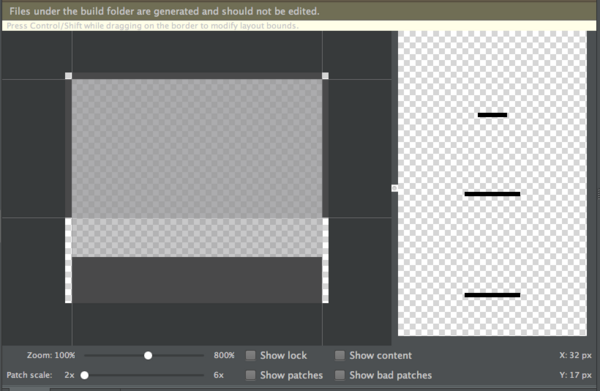谈谈Android Material Design 中的Tint(着色)
什么是Tint
当我开始接触 Tint 这个词的时候,其实是蛮不理解它的意思的,以及并不清楚Google发明它的目的,它一般搭配 Background 配合使用,但是现在已经有了 Background ,为什么还需要 Tint 呢?
Tint 翻译为 着色 。
着色,着什么色呢?和背景有关,当然是着背景的色。当我开发客户端,使用了 appcompat-v7 包的时候,为了实现 Material Design 的效果,我们会去设置主题里的几个颜色,重要的比如 primaryColor , colorControlNormal , colorControlActived 等等,而我们使用的一些组件,比如 EditText 就会自动变成我们想要的背景颜色,在背景图只有一张的情况下,这样的做法极大的减少了我们apk包的大小。
实现的方式就是用一个颜色为我们的背景图片设置 tint (着色)。
例子:

看看即将发布的 SegmentFault for Android 2.7 中,发布问题功能,这个EditText的颜色和我们的主要颜色相同。它利用了 TintManager 这个类,为自己的背景进行着色(绿色)。
那么这个原始图是什么样子呢?我们从 appcompat-v7 包中找到了这个图,是一个 .9 图,样子如下:
 其实它只是一个黑色的条,通过绿色的着色,变成了一个绿色的条。 就是这样的设计方式,使得我们在
其实它只是一个黑色的条,通过绿色的着色,变成了一个绿色的条。 就是这样的设计方式,使得我们在 Material Design 中省了多少资源文件呀!
好了,既然理解了 tint 的含义,我们赶紧看下这一切是如何实现的吧。
其实底层特别简单,了解过渲染的同学应该知道 PorterDuffColorFilter 这个东西,我们使用 SRC_IN 的方式,对这个Drawable进行颜色方面的渲染,就是在这个Drawable中有像素点的地方,再用我们的过滤器着色一次。
实际上如果要我们自己实现,只用获取 View 的 backgroundDrawable 之后,设置下 colorFilter 即可。
看下最核心的代码就这么几行
javaif (filter == null) { // Cache miss, so create a color filter and add it to the cache filter = new PorterDuffColorFilter(color, mode); } d.setColorFilter(filter);
通常情况下,我们的mode一般都是 SRC_IN ,如果想了解这个属性相关的资料,这里是传送门: http://blog.csdn.net/t12x3456/article/details/10432935 (中文)
由于 API Level 21 以前不支持 background tint 在xml中设置,于是提供了 ViewCompat.setBackgroundTintList 方法和 ViewCompat.setBackgroundTintMode 用来手动更改需要着色的颜色,但要求相关的View继承 TintableBackgroundView 接口。
源码解析
看下源码是如何实现的吧,我们以 AppCompatEditText 为例:
看下构造函数(省略无关代码)
javapublic AppCompatEditText(Context context, AttributeSet attrs, int defStyleAttr) { super(TintContextWrapper.wrap(context), attrs, defStyleAttr); ... ColorStateList tint = a.getTintManager().getTintList(a.getResourceId(0, -1)); //根据背景的resource id获取内置的着色颜色。 if (tint != null) { setInternalBackgroundTint(tint); //设置着色 } ... } private void setInternalBackgroundTint(ColorStateList tint) { if (tint != null) { if (mInternalBackgroundTint == null) { mInternalBackgroundTint = new TintInfo(); } mInternalBackgroundTint.mTintList = tint; mInternalBackgroundTint.mHasTintList = true; } else { mInternalBackgroundTint = null; } //上面的代码是记录tint相关的信息。 applySupportBackgroundTint(); //对背景应用tint } private void applySupportBackgroundTint() { if (getBackground() != null) { if (mBackgroundTint != null) { TintManager.tintViewBackground(this, mBackgroundTint); } else if (mInternalBackgroundTint != null) { TintManager.tintViewBackground(this, mInternalBackgroundTint); //最重要的,对tint进行应用 } } }
然后我们进入 tintViewBackground 看下 TintManager 里面的源码
javapublic static void tintViewBackground(View view, TintInfo tint) { final Drawable background = view.getBackground(); if (tint.mHasTintList) { //如果设置了tint的话,对背景设置PorterDuffColorFilter setPorterDuffColorFilter( background, tint.mTintList.getColorForState(view.getDrawableState(), tint.mTintList.getDefaultColor()), tint.mHasTintMode ? tint.mTintMode : null); } else { background.clearColorFilter(); } if (Build.VERSION.SDK_INT <= 10) { // On Gingerbread, GradientDrawable does not invalidate itself when it's ColorFilter // has changed, so we need to force an invalidation view.invalidate(); } } private static void setPorterDuffColorFilter(Drawable d, int color, PorterDuff.Mode mode) { if (mode == null) { // If we don't have a blending mode specified, use our default mode = DEFAULT_MODE; } // First, lets see if the cache already contains the color filter PorterDuffColorFilter filter = COLOR_FILTER_CACHE.get(color, mode); if (filter == null) { // Cache miss, so create a color filter and add it to the cache filter = new PorterDuffColorFilter(color, mode); COLOR_FILTER_CACHE.put(color, mode, filter); } // 最最重要,原来是对background drawable设置了colorFilter 完成了我们要的功能。 d.setColorFilter(filter); }
以上是对API21以下的兼容。
如果我们要实现自己的 AppCompat 组件实现 tint 的一些特性的话,我们就可以指定好 ColorStateList ,利用 TintManager 对自己的背景进行着色,当然需要对外开放设置的接口的话,我们还要实现 TintableBackgroundView 接口,然后用 ViewCompat.setBackgroundTintList 进行设置,这样能完成对v7以上所有版本的兼容。
实例
比如我现在要对一个自定义组件实现对 Tint 的支持,其实只用继承下,加一些代码就好了,代码如下(几乎通用):
public class AppCompatFlowLayout extends FlowLayout implements TintableBackgroundView { private static final int[] TINT_ATTRS = { android.R.attr.background }; private TintInfo mInternalBackgroundTint; private TintInfo mBackgroundTint; private TintManager mTintManager; public AppCompatFlowLayout(Context context) { this(context, null); } public AppCompatFlowLayout(Context context, AttributeSet attributeSet) { this(context, attributeSet, 0); } public AppCompatFlowLayout(Context context, AttributeSet attributeSet, int defStyle) { super(context, attributeSet, defStyle); if (TintManager.SHOULD_BE_USED) { TintTypedArray a = TintTypedArray.obtainStyledAttributes(getContext(), attributeSet, TINT_ATTRS, defStyle, 0); if (a.hasValue(0)) { ColorStateList tint = a.getTintManager().getTintList(a.getResourceId(0, -1)); if (tint != null) { setInternalBackgroundTint(tint); } } mTintManager = a.getTintManager(); a.recycle(); } } private void applySupportBackgroundTint() { if (getBackground() != null) { if (mBackgroundTint != null) { TintManager.tintViewBackground(this, mBackgroundTint); } else if (mInternalBackgroundTint != null) { TintManager.tintViewBackground(this, mInternalBackgroundTint); } } } @Override protected void drawableStateChanged() { super.drawableStateChanged(); applySupportBackgroundTint(); } private void setInternalBackgroundTint(ColorStateList tint) { if (tint != null) { if (mInternalBackgroundTint == null) { mInternalBackgroundTint = new TintInfo(); } mInternalBackgroundTint.mTintList = tint; mInternalBackgroundTint.mHasTintList = true; } else { mInternalBackgroundTint = null; } applySupportBackgroundTint(); } @Override public void setSupportBackgroundTintList(ColorStateList tint) { if (mBackgroundTint == null) { mBackgroundTint = new TintInfo(); } mBackgroundTint.mTintList = tint; mBackgroundTint.mHasTintList = true; applySupportBackgroundTint(); } @Nullable @Override public ColorStateList getSupportBackgroundTintList() { return mBackgroundTint != null ? mBackgroundTint.mTintList : null; } @Override public void setSupportBackgroundTintMode(PorterDuff.Mode tintMode) { if (mBackgroundTint == null) { mBackgroundTint = new TintInfo(); } mBackgroundTint.mTintMode = tintMode; mBackgroundTint.mHasTintMode = true; applySupportBackgroundTint(); } @Nullable @Override public PorterDuff.Mode getSupportBackgroundTintMode() { return mBackgroundTint != null ? mBackgroundTint.mTintMode : null; } } 赶快去试试吧~
欢迎关注我 Github 以及@Gemini










![[HBLOG]公众号](https://www.liuhaihua.cn/img/qrcode_gzh.jpg)

